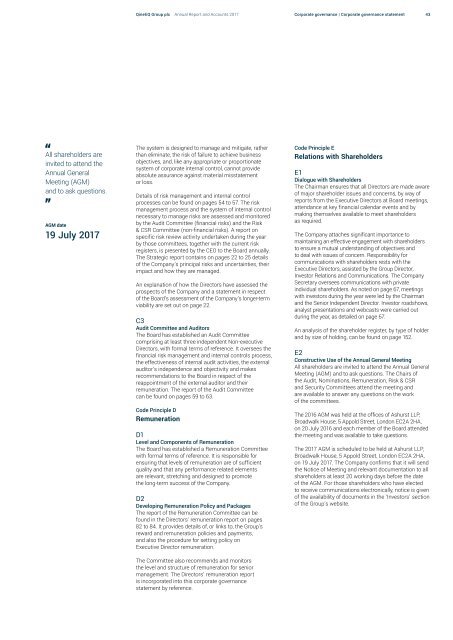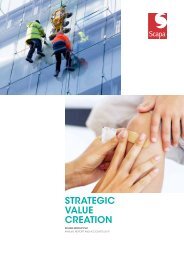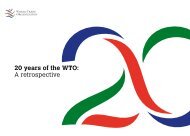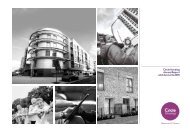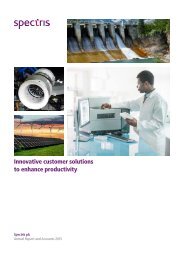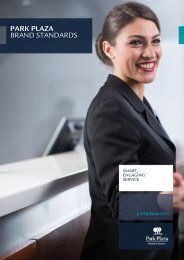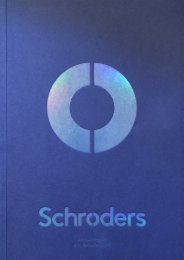QinetiQ Annual Report 2017
Create successful ePaper yourself
Turn your PDF publications into a flip-book with our unique Google optimized e-Paper software.
<strong>QinetiQ</strong> Group plc <strong>Annual</strong> <strong>Report</strong> and Accounts <strong>2017</strong><br />
Corporate governance | Corporate governance statement<br />
43<br />
All shareholders are<br />
invited to attend the<br />
<strong>Annual</strong> General<br />
Meeting (AGM)<br />
and to ask questions.<br />
AGM date<br />
19 July <strong>2017</strong><br />
The system is designed to manage and mitigate, rather<br />
than eliminate, the risk of failure to achieve business<br />
objectives, and, like any appropriate or proportionate<br />
system of corporate internal control, cannot provide<br />
absolute assurance against material misstatement<br />
or loss.<br />
Details of risk management and internal control<br />
processes can be found on pages 54 to 57. The risk<br />
management process and the system of internal control<br />
necessary to manage risks are assessed and monitored<br />
by the Audit Committee (financial risks) and the Risk<br />
& CSR Committee (non-financial risks). A report on<br />
specific risk review activity undertaken during the year<br />
by those committees, together with the current risk<br />
registers, is presented by the CEO to the Board annually.<br />
The Strategic report contains on pages 22 to 25 details<br />
of the Company’s principal risks and uncertainties, their<br />
impact and how they are managed.<br />
An explanation of how the Directors have assessed the<br />
prospects of the Company and a statement in respect<br />
of the Board’s assessment of the Company’s longer-term<br />
viability are set out on page 22.<br />
C3<br />
Audit Committee and Auditors<br />
The Board has established an Audit Committee<br />
comprising at least three independent Non-executive<br />
Directors, with formal terms of reference. It oversees the<br />
financial risk management and internal controls process,<br />
the effectiveness of internal audit activities, the external<br />
auditor’s independence and objectivity and makes<br />
recommendations to the Board in respect of the<br />
reappointment of the external auditor and their<br />
remuneration. The report of the Audit Committee<br />
can be found on pages 59 to 63.<br />
Code Principle D<br />
Remuneration<br />
D1<br />
Level and Components of Remuneration<br />
The Board has established a Remuneration Committee<br />
with formal terms of reference. It is responsible for<br />
ensuring that levels of remuneration are of sufficient<br />
quality and that any performance related elements<br />
are relevant, stretching and designed to promote<br />
the long-term success of the Company.<br />
D2<br />
Developing Remuneration Policy and Packages<br />
The report of the Remuneration Committee can be<br />
found in the Directors’ remuneration report on pages<br />
82 to 84. It provides details of, or links to, the Group’s<br />
reward and remuneration policies and payments,<br />
and also the procedure for setting policy on<br />
Executive Director remuneration.<br />
The Committee also recommends and monitors<br />
the level and structure of remuneration for senior<br />
management. The Directors’ remuneration report<br />
is incorporated into this corporate governance<br />
statement by reference.<br />
Code Principle E<br />
Relations with Shareholders<br />
E1<br />
Dialogue with Shareholders<br />
The Chairman ensures that all Directors are made aware<br />
of major shareholder issues and concerns, by way of<br />
reports from the Executive Directors at Board meetings,<br />
attendance at key financial calendar events and by<br />
making themselves available to meet shareholders<br />
as required.<br />
The Company attaches significant importance to<br />
maintaining an effective engagement with shareholders<br />
to ensure a mutual understanding of objectives and<br />
to deal with issues of concern. Responsibility for<br />
communications with shareholders rests with the<br />
Executive Directors, assisted by the Group Director,<br />
Investor Relations and Communications. The Company<br />
Secretary oversees communications with private<br />
individual shareholders. As noted on page 67, meetings<br />
with investors during the year were led by the Chairman<br />
and the Senior Independent Director. Investor roadshows,<br />
analyst presentations and webcasts were carried out<br />
during the year, as detailed on page 67.<br />
An analysis of the shareholder register, by type of holder<br />
and by size of holding, can be found on page 152.<br />
E2<br />
Constructive Use of the <strong>Annual</strong> General Meeting<br />
All shareholders are invited to attend the <strong>Annual</strong> General<br />
Meeting (AGM) and to ask questions. The Chairs of<br />
the Audit, Nominations, Remuneration, Risk & CSR<br />
and Security Committees attend the meeting and<br />
are available to answer any questions on the work<br />
of the committees.<br />
The 2016 AGM was held at the offices of Ashurst LLP,<br />
Broadwalk House, 5 Appold Street, London EC2A 2HA,<br />
on 20 July 2016 and each member of the Board attended<br />
the meeting and was available to take questions.<br />
The <strong>2017</strong> AGM is scheduled to be held at Ashurst LLP,<br />
Broadwalk House, 5 Appold Street, London EC2A 2HA,<br />
on 19 July <strong>2017</strong>. The Company confirms that it will send<br />
the Notice of Meeting and relevant documentation to all<br />
shareholders at least 20 working days before the date<br />
of the AGM. For those shareholders who have elected<br />
to receive communications electronically, notice is given<br />
of the availability of documents in the ‘Investors’ section<br />
of the Group’s website.


